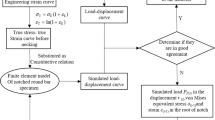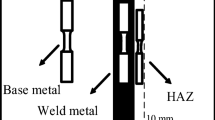Abstract
Structural steel (E250 grade) is used in several engineering applications involving loadings from quasi-static to high strain rates (blast discs, explosion vents, etc.), which introduce large deformation, strain and strain rate hardening, thermal softening, and damage to the material. The material’s dynamic constitutive behaviour can be aptly modelled by a visco-plasticity-based Johnson–Cook (J–C) strength model and damage initiation and complete failure by the J–C’s damage model. In the latter, damage initiation is modelled through continuum damage mechanics and propagation by the fracture mechanics. This paper focuses on the determination of 10 different J–C’s dynamic constitutive and damage model parameters for E250 structural steel by conducting several experiments involving tensile tests at different strain rates (0.0003–1.0 s-1), stress triaxialities (0.33–0.95), temperatures (30–800 °C), and SHPB experiments (at 3000 and 8000 s-1). It explains the processes and step-by-step procedures for extracting the model parameters from the experimental results. A different approach is followed in arriving at fracture strain for extracting damage model parameters to suit fracture mechanic-based damage evolution available in the existing FEA codes. The constitutive and damage model parameters thus determined are validated through numerical simulations and comparison with three independent experiments viz. i) experiment of a plain tensile specimen, ii) tensile experiment of a notched specimen, and iii) hydrostatic burst experiment of a flat burst disc. The responses and failure patterns from numerical simulations agreed very well in all three experiments, thereby validating the determined model parameters. The determined model parameters can be utilised directly in the commercially available nonlinear explicit FEA codes.

























Similar content being viewed by others
Data Availability
All the data required to reproduce these findings are provided in the manuscript as graphs instead of raw data. This is also used as part of an ongoing study by the authors.
Abbreviations
- A :
-
J–C parameter representing yield stress (MPa)
- A s :
-
Cross-sectional area of SHPB specimen (mm2)
- A t :
-
Cross-sectional area of the incident and transmitter bars (mm2)
- A 0 :
-
Initial cross-sectional area of the tensile specimen (mm2)
- A f :
-
Cross-sectional area of the tensile specimen after the experiment (mm2)
- B :
-
Strain hardening coefficient (MPa)
- C :
-
Strain rate coefficient
- c 0 :
-
Fundamental longitudinal velocity of the elastic stress wave (m/s)
- D i :
-
Damage initiation variable
- D :
-
Damage propagation variable
- D 1 , D 2 , D 3 :
-
Stress triaxiality dependent fracture strain parameters
- D 4 :
-
Strain rate dependent fracture strain parameter
- D 5 :
-
Temperature dependent fracture strain parameter
- E :
-
Young’s modulus (MPa)
- G f :
-
Fracture energy (N/mm)
- L s :
-
The thickness of the specimen in the SHPB experiment (mm)
- m :
-
Thermal softening exponent
- n :
-
Strain hardening exponent
- P :
-
Equivalent force in the incident and transmitted bar (N)
- P 1, P 2 :
-
Forces on the left and right end of the specimen in SHPB experiment (N)
- \(\dot{P}\) :
-
Incident pressure loading rate in burst experiment (MPa/s)
- P b :
-
Burst pressure (MPa)
- T :
-
Temperature in material (°C)
- \({T}^{*}\) :
-
Homologous temperature (°C)
- \({T}_{0}\) :
-
Reference temperature (°C)
- \({T}_{\mathrm{m}}\) :
-
Melting temperature of the material (°C)
- t :
-
Time interval for the stress wave propagation through an element (s)
- t d :
-
Natural time period (s)
- u 1, u 2 :
-
Displacements at the left and right end of the specimen in the SHPB experiment
- \({u}^{\mathrm{pl}}\) :
-
Plastic displacement
- \({u}_{\mathrm{f}}^{\mathrm{pl}}\) :
-
Plastic displacement at failure
- w l :
-
Crack tip opening displacement (mm)
- x, y :
-
Horizontal and vertical coordinate axes, respectively
- σ :
-
True stress/von-Mises tensile flow stress (MPa)
- \({\sigma }_{\mathrm{m}}\) :
-
Average of the three normal stresses, i.e. mean stress (MPa)
- \(\tilde{\sigma }\) :
-
Von-Mises equivalent stress (MPa)
- σ * :
-
Dimensionless pressure, i.e. stress ratio or stress triaxiality
- \({\sigma }_{0}\) :
-
Stress at the onset of damage (MPa)
- \({\sigma }_{\mathrm{t}}\) :
-
Tensile strength of the material (MPa)
- \({\sigma }_{\mathrm{y}}\) :
-
Dynamic yield stress (MPa)
- \({\sigma }_{\mathrm{D}}\) :
-
Stress at damaged state (MPa)
- \(\varepsilon\) :
-
True strain/plastic strain
- \({\varepsilon }_{0}\) :
-
Equivalent plastic strain at the onset of damage
- \(\dot{\varepsilon }\) :
-
Strain rate (s−1)
- \({\dot{\varepsilon }}_{0}\) :
-
Reference strain rate (s−1)
- \({\dot{\varepsilon }}^{*}\) :
-
Dimensionless normalised plastic strain rate
- \({\dot{\varepsilon }}_{\mathrm{s}}\) :
-
Strain rate in SHPB specimen (s−1)
- \({\varepsilon }_{\mathrm{f}}\) :
-
Fracture strain
- \({\varepsilon }_{\mathrm{i}}\) :
-
Incident strain pulse
- \({\varepsilon }_{\mathrm{r}}\) :
-
Reflected strain pulse
- \({\varepsilon }_{\mathrm{s}}\) :
-
Strain in SHPB specimen
- \({\varepsilon }_{\mathrm{t}}\) :
-
Transmitted strain pulse
- \(\Delta \varepsilon\) :
-
Incremental plastic strain
- \({\omega }_{\mathrm{n}}\) :
-
Fundamental natural frequency (Hz)
- ρ :
-
Density of the material (kg/m3)
References
C.L. Rao, V. Narayanamurthy, and K.R.Y. Simha, Applied Impact Mechanics, Wiley, Hoboken, 2016. https://doi.org/10.1002/9781119241829
G.R. Johnson and W.H. Cook, A Constitutive Model and Data from Metals Subjected to Large Strains, High Strain Rates and High Temperatures. In: Proceedings: Seventh International Symposium on Ballistics, Netherlands. 541–547 (1983)
G.R. Johnson and W.H. Cook, Fracture Characteristics of Three Metals Subjected to Various Strains, Strain Rates, Temperatures and Pressures, Eng. Fract. Mech., 1985, 21(1), p 31–48. https://doi.org/10.1016/0013-7944(85)90052-9
K. Vedantam, D. Bajaj, N.S. Brar, and S. Hill, Johnson - Cook Strength Models for Mild and DP 590 Steels, AIP Conf. Proc., 2006, 845(1), p 775–778. https://doi.org/10.1063/1.2263437
Z. Xu and F. Huang, Plastic Behavior and Constitutive Modelling of Armor Steel Over Wide Temperature and Strain Rate Ranges, Acta Mech. Solida Sin., 2012, 25(6), p 598–608. https://doi.org/10.1016/S0894-9166(12)60055-X
A. Banerjee, S. Dhar, S. Acharyya, D. Datta, and N. Nayak, Determination of Johnson Cook Material and Failure Model Constants and Numerical Modelling of Charpy Impact Test Of Armour Steel, Mat. Sci. Eng. A, 2015, 640, p 200–209. https://doi.org/10.1016/j.msea.2015.05.073
H.K. Farahani, M. Ketabchi, and S. Zangeneh, Determination of Johnson–Cook Plasticity Model Parameters for Inconel 718, J. Mat. Eng. Perform., 2017, 26(11), p 5284–5293. https://doi.org/10.1007/s11665-017-2990-2
M. Murugesan and D.W. Jung, Johnson Cook Material and Failure Model Parameters Estimation of AISI-1045 Medium Carbon Steel for Metal Forming Applications, Materials., 2019, 12(4), p 609. https://doi.org/10.3390/ma12040609
G.H. Majzoobi and F.R. Dehgolan, Determination of the Constants of Damage Models, Proced. Eng., 2011, 10, p 764–773. https://doi.org/10.1016/j.proeng.2011.04.127
B. Bal, K.K. Karaveli, B. Cetin, and B. Gumus, The Precise Determination of the Johnson–Cook Material and Damage Model Parameters and Mechanical Properties of an Aluminum 7068–T651 Alloy, J. Eng. Mat. Tech., 2019, 141(4), p 141001. https://doi.org/10.1115/1.4042870
T. Børvik, M. Langseth, O.S. Hopperstad, and K.A. Malo, Ballistic Penetration of Steel Plates, Int. J. Imp. Engg., 1999, 22(9–10), p 855–886. https://doi.org/10.1016/S0734-743X(99)00011-1
J. Lemaitre, A Course on Damage Mechanics, Springer, Berlin Heidelberg, 2012.
R.W. Hertzberg, Deformation and Fracture Mechanics of Engineering Materials, Wiley, United Kingdom, 1996.
V. Satopaa, J. Albrecht, D. Irwin, and B. Raghavan, Finding a "Kneedle" in a Haystack: Detecting Knee Points in System Behavior. In: 31st International Conference on Distributed Computing Systems Workshops. 166-171 (2011) doi: https://doi.org/10.1109/ICDCSW.2011.20.
Abaqus User Manual, V6.14: Dassault Systèmes Simulia Corporation, France (2014)
A. Hillerborg, M. Modéer, and P.E. Petersson, Analysis of Crack Formation and Crack Growth in Concrete by Means of Fracture Mechanics and Finite Elements, Cem. Concr. Res., 1976, 6(6), p 773–781. https://doi.org/10.1016/0008-8846(76)90007-7
W.E. Baker, P.A. Cox, J.J. Kulesz, R.A. Strehlow, and P.S. Westine, Explosion Hazards and Evaluation, Elsevier Science, Netherlands, 2012.
Acknowledgments
The authors thank the support provided by Mr. Swati Kiran, Research Scholar at IIT Hyderabad and engineers at our Laboratory in conducting various experiments.
Author information
Authors and Affiliations
Corresponding author
Ethics declarations
Conflict of interest
On behalf of all authors, the corresponding author states that there is no conflict of interest. The authors have no competing interests to declare that are relevant to the content of this article.
Additional information
Publisher's Note
Springer Nature remains neutral with regard to jurisdictional claims in published maps and institutional affiliations.
Rights and permissions
Springer Nature or its licensor (e.g. a society or other partner) holds exclusive rights to this article under a publishing agreement with the author(s) or other rightsholder(s); author self-archiving of the accepted manuscript version of this article is solely governed by the terms of such publishing agreement and applicable law.
About this article
Cite this article
Gopinath, K., Narayanamurthy, V., Khaderi, S.N. et al. Determination of Parameters for Johnson-Cook Dynamic Constitutive and Damage Models for E250 Structural Steel and Experimental Validations. J. of Materi Eng and Perform (2023). https://doi.org/10.1007/s11665-023-08733-4
Received:
Revised:
Accepted:
Published:
DOI: https://doi.org/10.1007/s11665-023-08733-4




